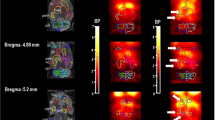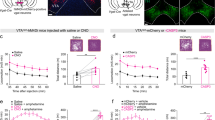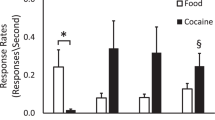Abstract
The rotational (circling) behaviour of rodents with unilateral nigrostriatal damage has been used extensively to investigate nigrostriatal function and the action of dopaminergic compounds1. Rats lesioned by unilateral microinjection of the catecholaminergic neurotoxin, 6-hydroxydopamine (6-OHDA), spontaneously exhibit slight ipsilateral (towards the lesioned side) rotation. Systemic challenge with the dopamine receptor agonist apomorphine induces active contralateral rotation, apparently as a result of supersensitivity in the lesioned hemisphere2,3. We report here that apomorphine treatment also results in an extraordinarily persistent change in spontaneous (undrugged) rotation. After one treatment with 50 µg per kg apomorphine, exposure to the rotation environment resulted in a brief, intense burst of contralateral rotation. This behaviour, apparent for months after drug treatment, did not fully develop until 2 weeks after treatment and was never observed in lesioned, but otherwise drug-naive rats. The latent apomorphine effect, unlike the acute effect, was inversely related to dose over the range tested. The behaviour was relatively specific for the environment in which drug treatment had occurred, suggesting a role for learning, but it is difficult to reconcile the inverse dose–response function, lack of recency effect and inability to induce an analogous phenomenon using (+)amphetamine with this explanation.
This is a preview of subscription content, access via your institution
Access options
Subscribe to this journal
Receive 51 print issues and online access
$199.00 per year
only $3.90 per issue
Buy this article
- Purchase on Springer Link
- Instant access to full article PDF
Prices may be subject to local taxes which are calculated during checkout
Similar content being viewed by others
References
Pycock, C. J. Neuroscience 5, 461–514 (1980).
Ungerstedt, U. Acta physiol. scand. Suppl. 367, 69–93 (1971).
Creese, I., Burt, D. R. & Snyder, S. H. Science 197, 596–598 (1977).
Pieri, M., Pieri, L., Saner, A., DaPrada, W. & Haefely, W. Archs int. Pharmacodyn. Thér. 217, 118–130 (1975).
Ungerstedt, U. Acta physiol. scand. Suppl. 367, 49–69 (1971); Pharmac. Ther. B2, 37–40 (1976).
Ungerstedt, U., Avemo, A., Avemo, E., Ljungbert, T. & Ranje, C. in Advances in Neurology Vol. 3 (ed. Calne, D. B.) 257–271 (Raven, New York, 1973).
Pieri, L., Pieri, M. & Haefely, W. Nature 252, 586–588 (1974).
Nowycky, M. C. & Roth, R. H. Prog. Neuro-psychopharmac. 2, 139 (1978).
Skirboll, L. R., Grace, A. A. & Bunney, B. S. Science 206, 80–82 (1979).
Martres, M. P. et al. Brain Res. 136, 319–337 (1977).
Kozlowski, M. R., Sawyer, S. & Marshall, J. F. Nature 287, 52–54 (1980).
Matefy, R. E. & Krall, R. G. Addict. Behav. 3, 165–178 (1978).
Author information
Authors and Affiliations
Rights and permissions
About this article
Cite this article
Silverman, P., Ho, B. Persistent behavioural effect of apomorphine in 6-hydroxydopamine-lesioned rats. Nature 294, 475–477 (1981). https://doi.org/10.1038/294475a0
Received:
Accepted:
Issue Date:
DOI: https://doi.org/10.1038/294475a0
This article is cited by
-
Quantifying muscle alterations in a Parkinson’s disease animal model using electromyographic biomarkers
Medical & Biological Engineering & Computing (2021)
-
Pavlovian conditioning ofl-dopa induced movement
Psychopharmacology (1992)
-
Pavlovian conditioning between co-administered drugs: elicitation of an apomorphine-induced antiparkinsonian response by scopolamine
Psychopharmacology (1991)
-
Cocaine and local anesthetics: Stimulant activity in rats with nigral lesions
Psychopharmacology (1990)
-
Kupalov’s concept of shortened conditional reflexes: Psychophysiological and psychopharmacological implications
The Pavlovian Journal of Biological Science (1989)
Comments
By submitting a comment you agree to abide by our Terms and Community Guidelines. If you find something abusive or that does not comply with our terms or guidelines please flag it as inappropriate.



